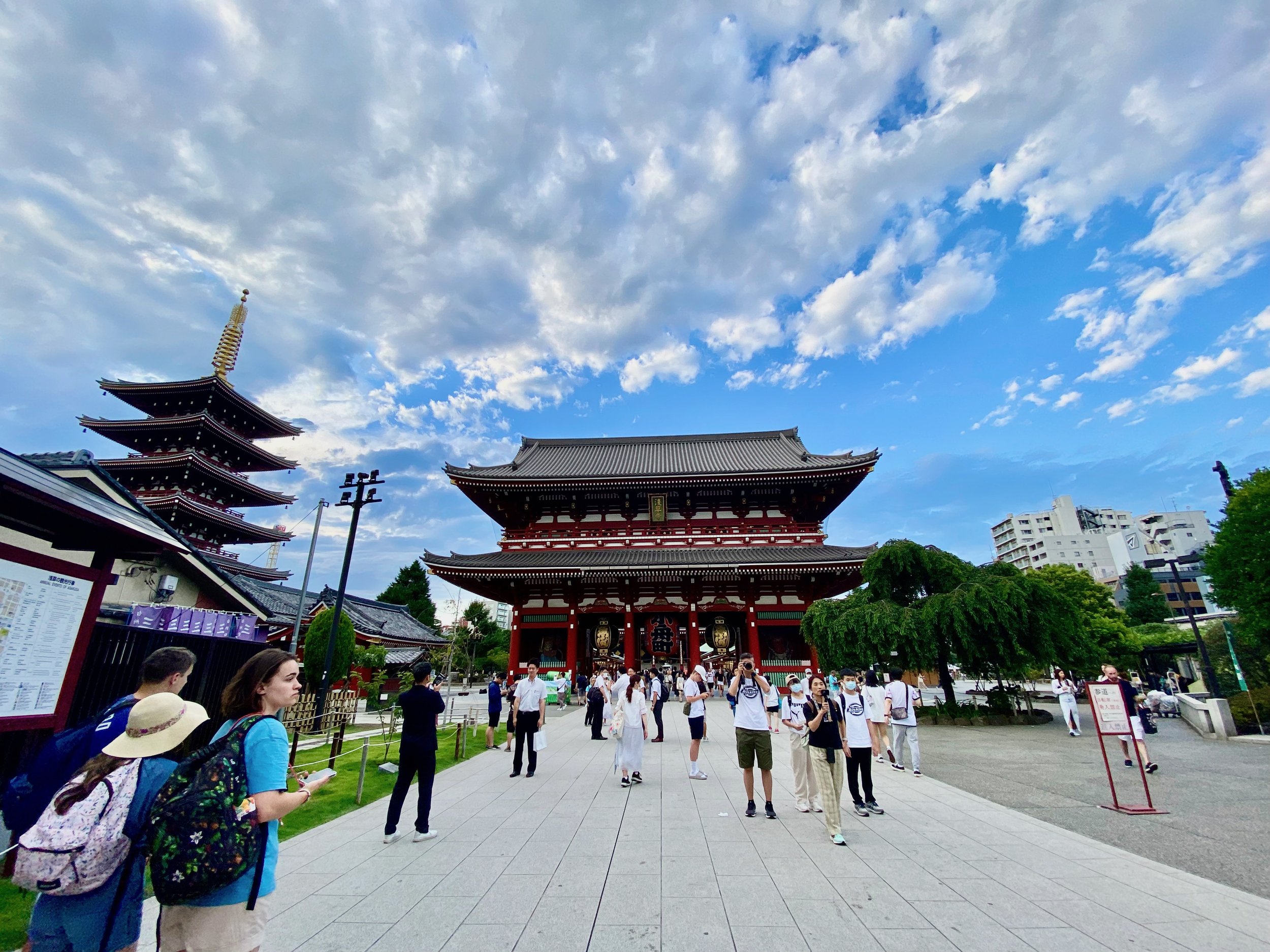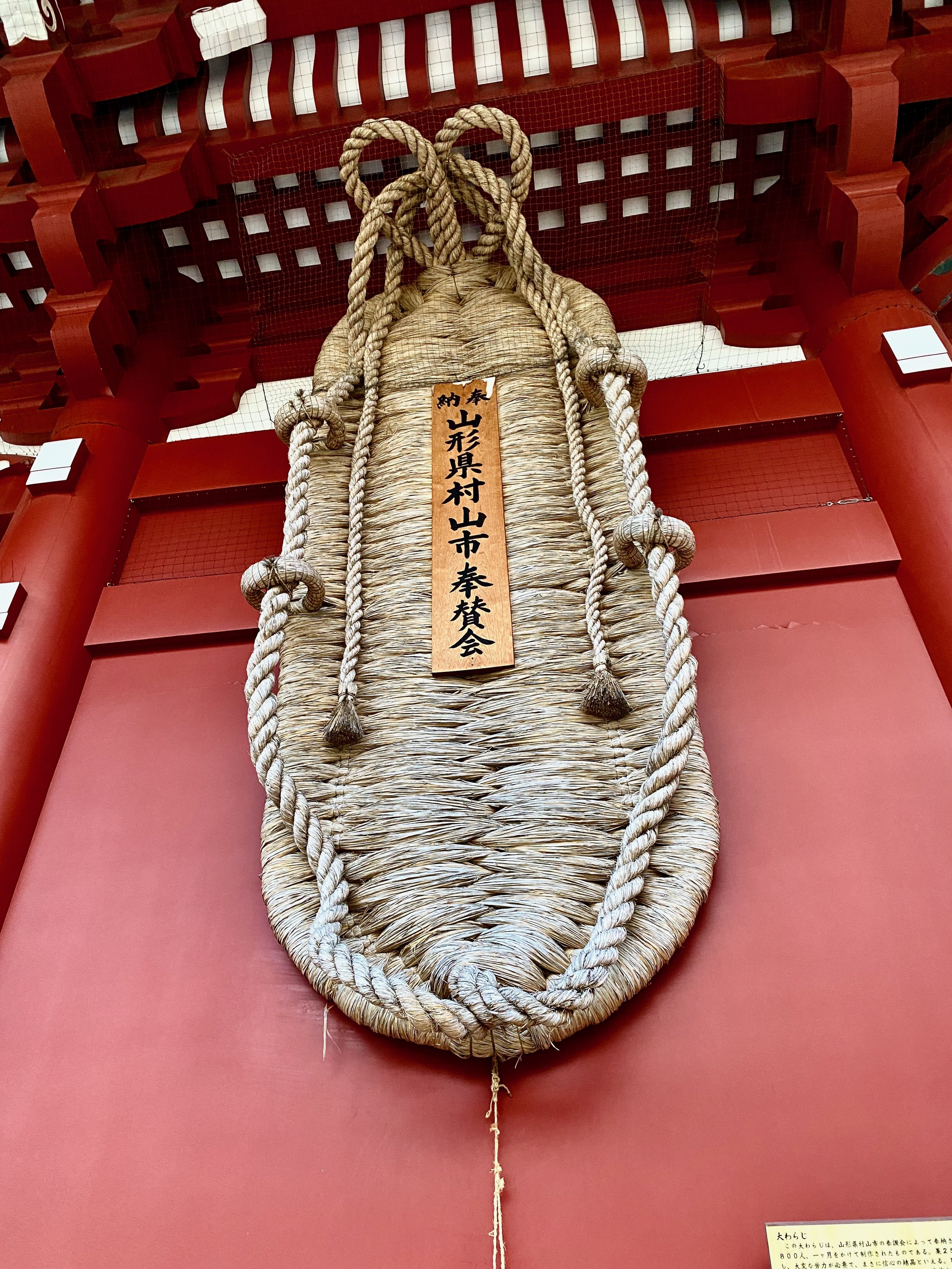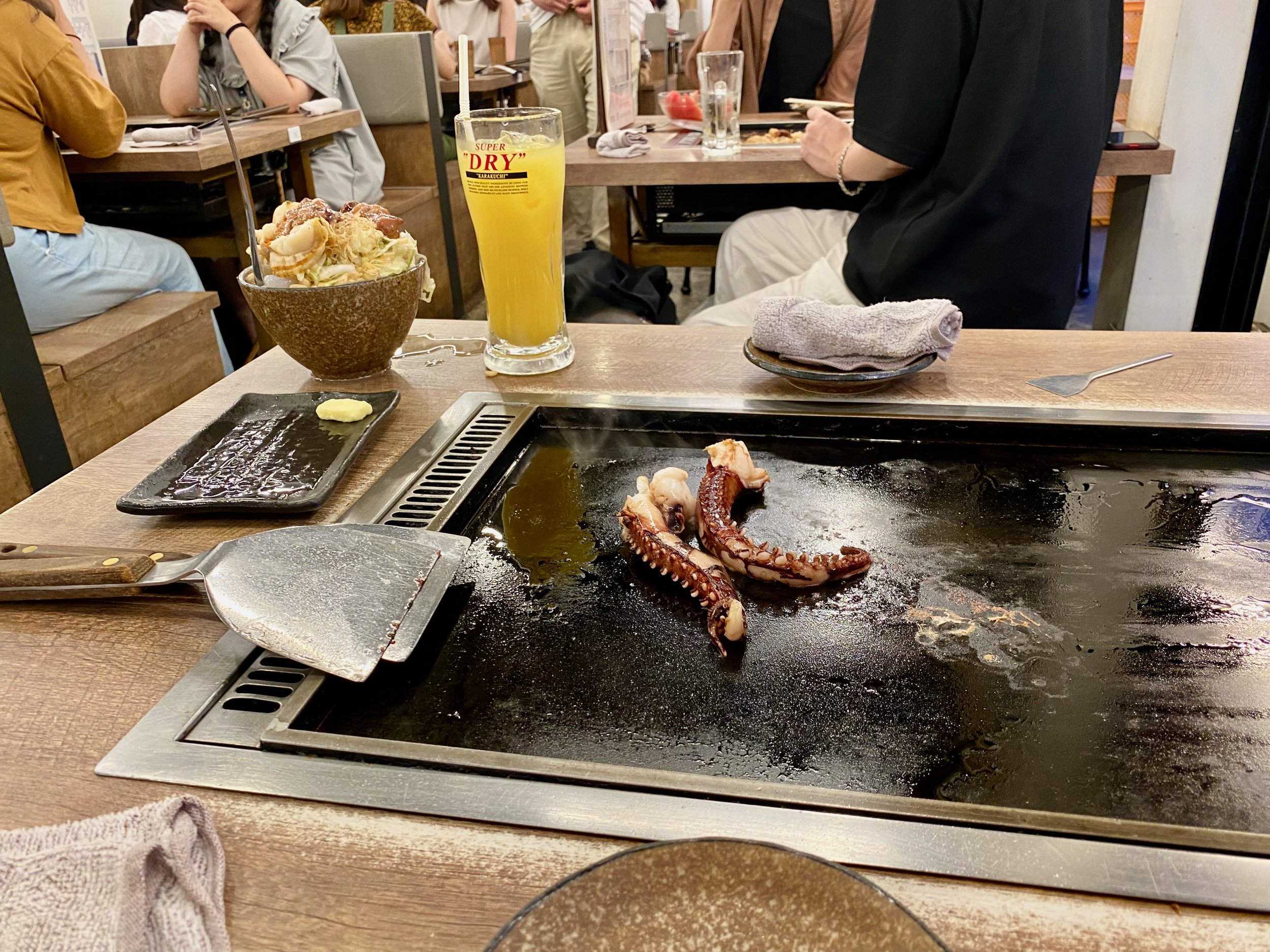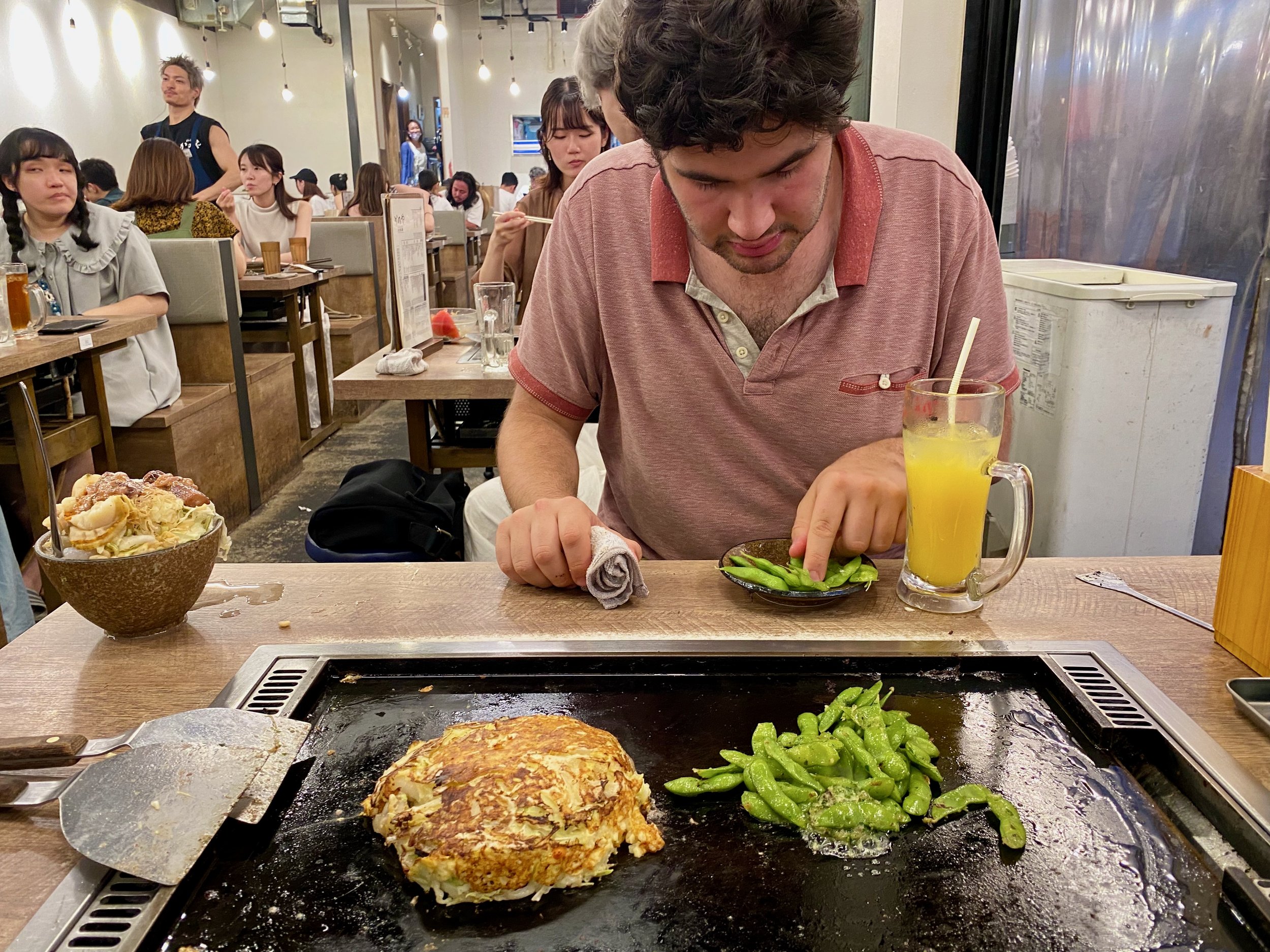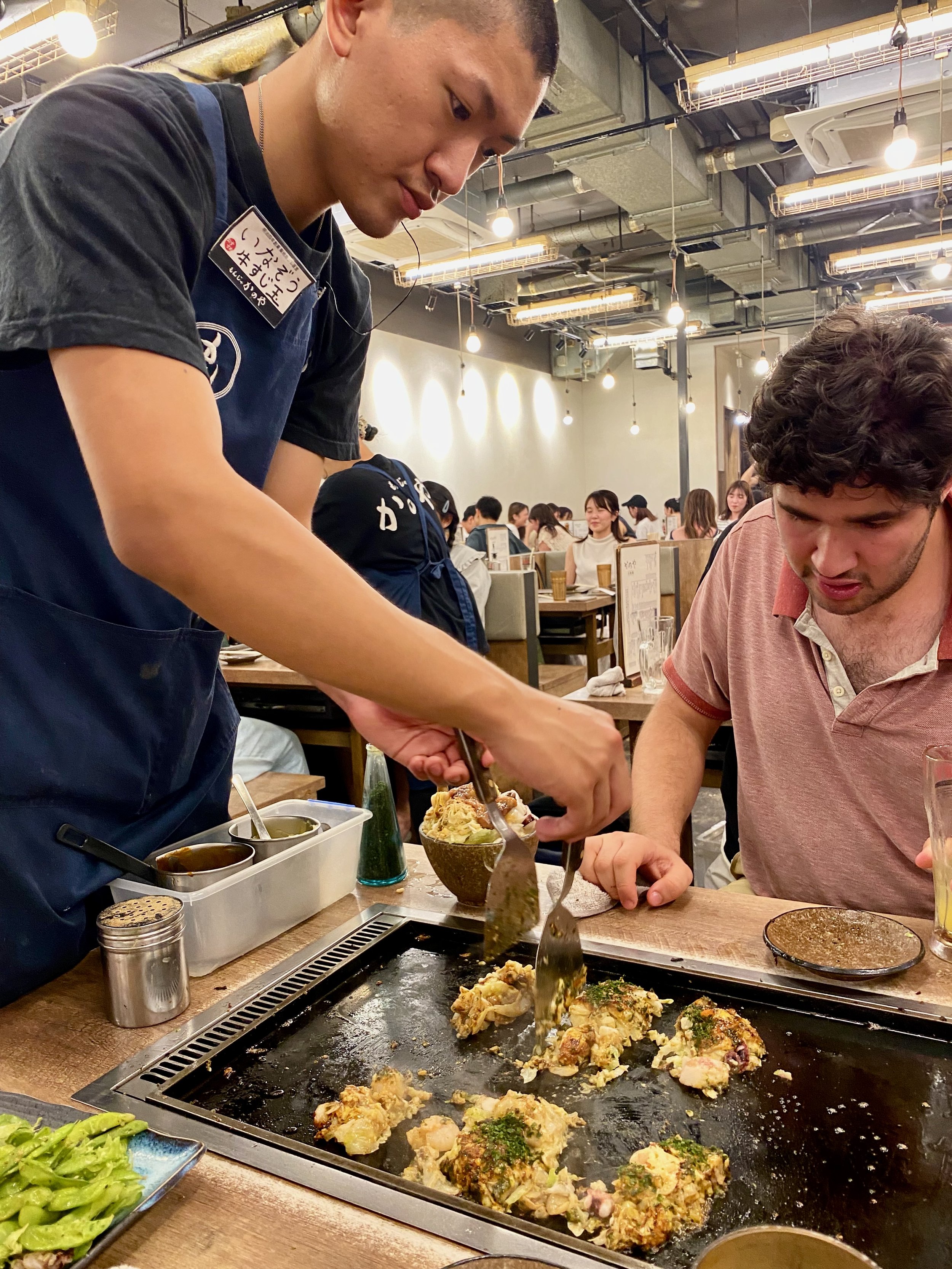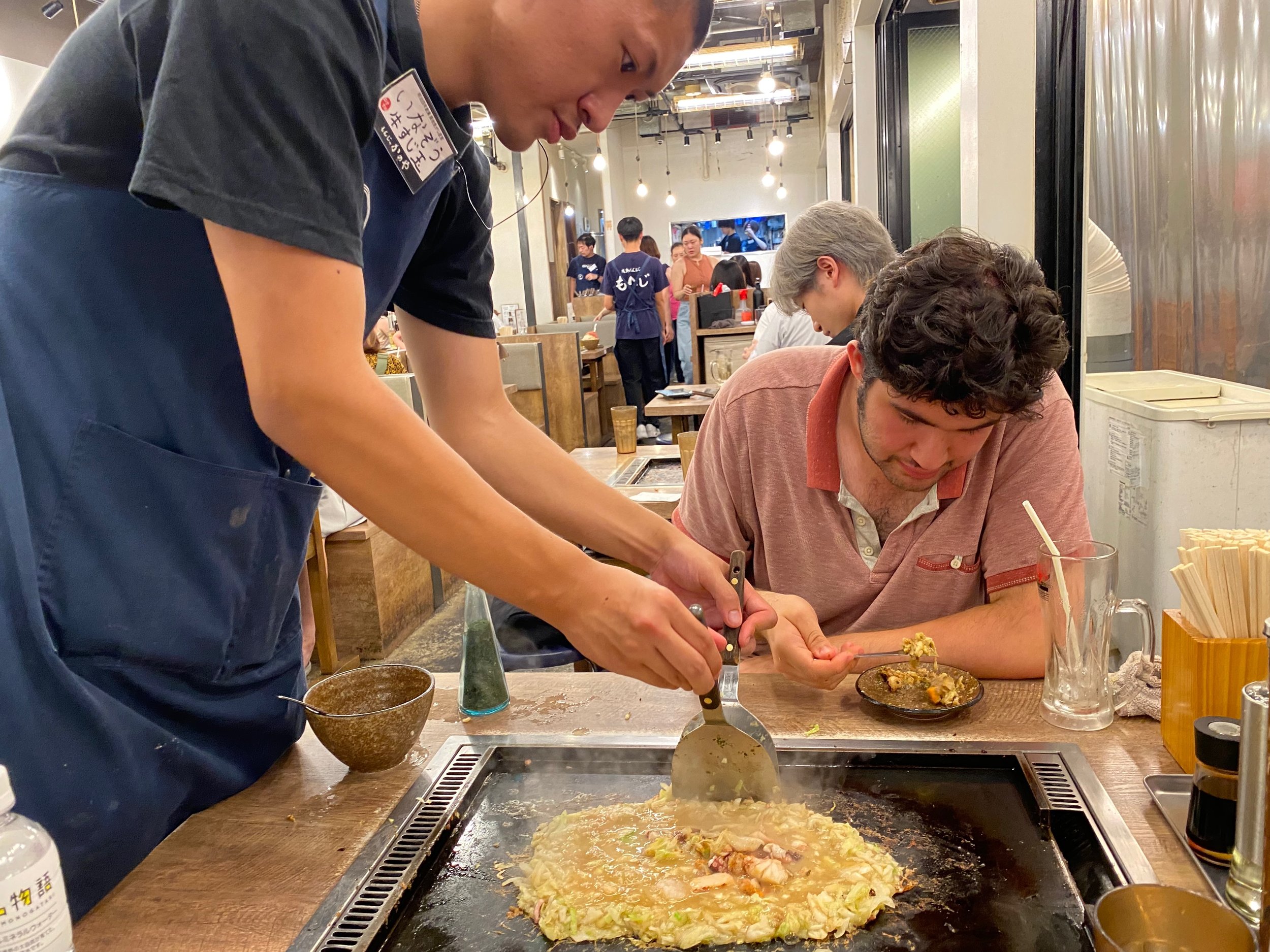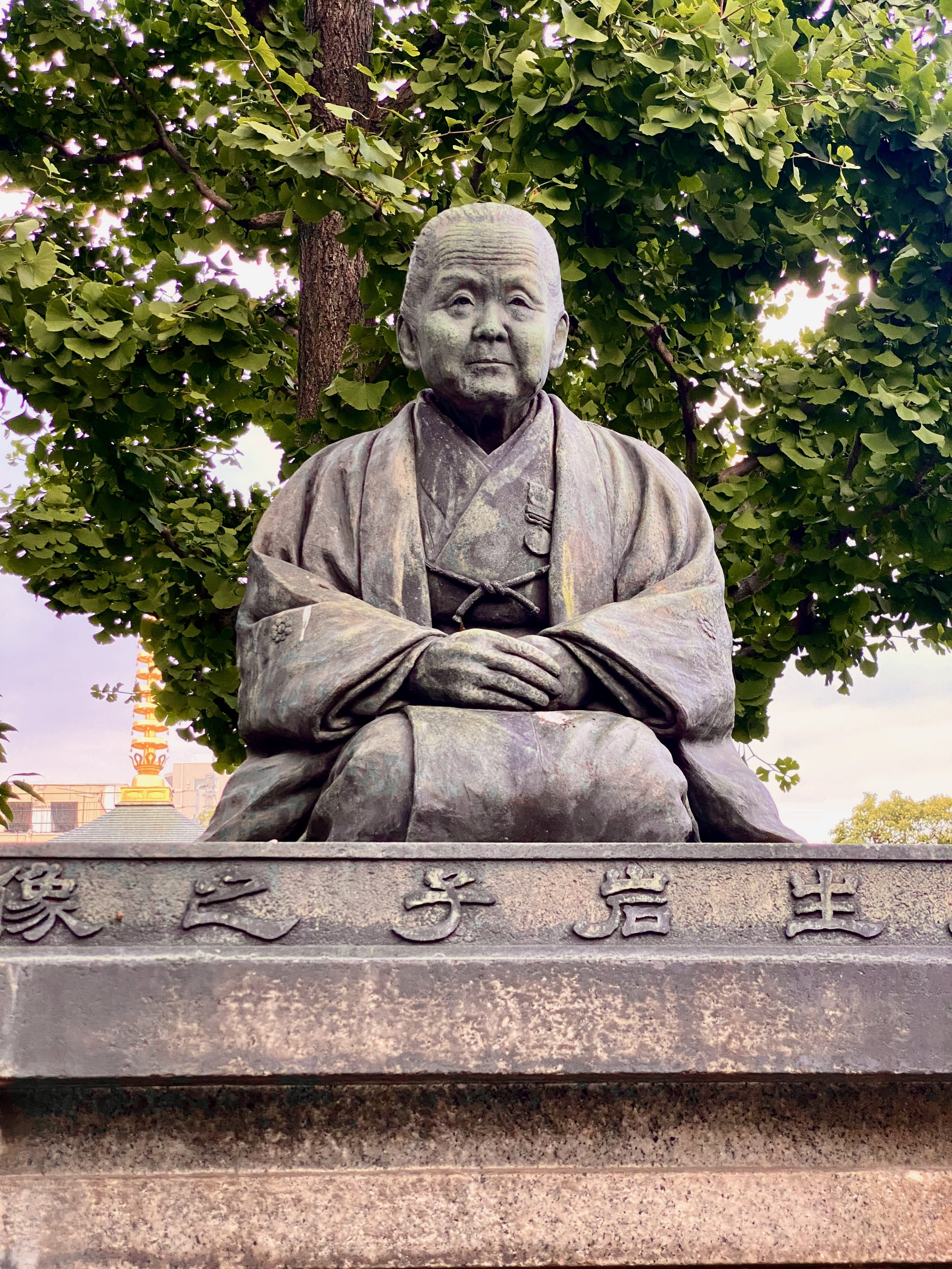Japan Journals 2: A Night in Asakusa
This is the second in a series of pieces about my trip to Japan this past summer with my wasband,* D, and my two sons, C (age 20) and E (age 15).
If you missed Japan Journals 1: Tokyo, you can find it here.
*a husband from whom one is amicably separated
Tokyo’s Asakusa neighborhood is hopping, and unlike Takeshita Street (which I wrote about in Japan Journals 1), the crowd of humans enjoying its alleys, restaurants, and covered outdoor market appears to contain more locals than tourists.
Here I encounter dogs for the first time in Japan. Small dogs, well-groomed, on-leash, many wearing glowing neon collars, trot obediently alongside their owners. They pass each other with nary a bark or a yank. My incorrigibly exuberant pups would probably get me arrested here.
D is meeting with colleagues tonight, and E has gone off in search of more clothes. Within the first 48 hours in Tokyo, fifteen-year-old E has absorbed the Metro system, and with the help of Google Maps and Google Translate he’s off to peruse a giant mall. Though well-versed in the city buses of Ann Arbor, Michigan, this is his first time traversing a foreign metropolis on his own. Fortun,ately Tokyo is not only the most populous city in the world, but also the safest. Although E maintains a perfect deadpan at all times, I sense his elation. Or perhaps I’m just projecting onto him the sense of wild liberation that comes to me, even now, when I find myself alone in the great wide world, ditching the expectations of ordinary life and following my senses the way a gull or a squirrel or an off-leash dog might, answerable to no one, if only for a week, or a day, or even an hour.
Now it’s just C and me and the Tokyo afternoon, and this too feels like liberation from my perpetual efforts to please two very different young men. Twenty-year-old C is always game for an adventure, and unlike E, he has no aversion to hanging out with his mom. Perhaps it’s because C is on the autism spectrum and therefore atypical in his development, but he has never exhibited that peculiar adolescent scorn for all things parental that’s been E’s default for the past year.
First we hit the famous Sensoji temple, where the ratio of tourists to locals increases dramatically. I tilt my camera upwards in an attempt to crop the ravening hordes out of my shot, but I can’t make it work. So annoying to have all these tourists intruding on my tourism.
We circle the striking crimson temple and the five-story pagoda with appropriate reverence, then gape at the fourteen-and-a-half-foot, 1100-pound owaraji affixed to the sides of the Hozomon Gate. These traditional straw sandals, reputed to ward off evil, were a gift to the temple from the city of Murayama. It took 800 citizens a year and a half to make them, and they replace them every ten years.
When C and I are templed out, we go in search of food.
I’ve noticed that Japanese people tend to keep quiet in public settings. Consideration for the experience of others is paramount. On the subway, people look at their phones, listen to music through earbuds, or converse in hushed tones. But on this Friday in Asakusa, as day fades into dusk and dusk into night, the volume rises, and groups of people—older men in particular—cluster at outdoor café tables, talking, drinking, and laughing. It’s as though the week has shed its suit and tie, opened a few buttons, loosened its belt, and let its belly relax.
C and I wander aimlessly, clutching each other’s hand, reveling in the unfamiliar sounds and smells. We pass through smokey clouds of grilled meat scent, steam redolent boiled rice, and the occasional whiff of dashi—the mushroom and fish base of most Japanese soups—that carries us, for a moment, to the sea.
We want to eat someplace popular with locals. We settle on a crowded spot where every table has a flat metal griddle at its center, and the waitstaff and customers are pushing the food around on the griddles with what look like small metal squeegees.
The host who seats us speaks no English, and I can’t read the menu. I open Google translate and point my phone at it, but it’s not much help.
A young woman who speaks a bit of English arrives to take our order. I ask her if they have anything vegetarian.
She says yes, but only cabbage.
I tell her fish is also okay.
“Fish,” she says. “Seafood?”
I nod.
C and I pick two dishes to share from the seafood portion of the menu, with no real concept of what we’re ordering. We place ourselves in the hands of the universe.
The young woman returns, coats the griddle with garlicky butter, then places what appear to be octopus tentacles on the buttery metal. She sets a bowl laden with seafood and cabbage on the edge of the table. She adjusts the heat and sets a timer. She points at the timer, then at the octopus, and gestures not to eat it yet.
Normally I don’t eat octopus, having read The Soul of an Octopus, which taught me a great deal about the eight-limbed mollusks’ personalities and intellects. But this is here and I’m here, and I’m determined to embrace the experience. I apologize inwardly to the spirit of Octopus and banish intrusive thoughts to the quiet room.
Our server returns a few minutes later, stirs the tentacles, slices them quickly into pieces, and resets the timer. She again shakes her head firmly, saying, “No eat.”
A couple minutes later she’s back again, carrying a second bowl filled with some kind of slurry. She turns off the timer, pushes the octopus tentacles to the far end of the griddle, and says, “Okay, eat.”
While we chase bites of octopus with our chopsticks, she empties the first bowl—which turned out to an egg mixture at the bottom—onto the other side of the griddle and sets the second bowl in its place. She herds it expertly around the metal surface, a spatula in each hand, scraping and flipping it in a kind of dance. She shapes it into a circle and resets the timer.
The octopus is fresh and flavorful, but in addition to my aforementioned scruples, I’ve never been a fan of that slight rubbery texture. I eat a few bites and pass the rest to C.
I notice some edamame at a nearby table and order that as well.
Soon a handsome young man appears with the edamame and introduces himself as our waiter. He apologizes for being late—I didn’t know he was—and asks how long we’ve been in the country.
“Two days!” I say, smiling wide.
He looks startled. After much back and forth, I realize he’d meant to ask how long we planned to be here rather than how long we’d been here so far. I tell him three and a half weeks. He seems relieved, and we all laugh at the misunderstanding.
“Where are you from?” he asks.
“California,” says C. (Although C is in college in California, and I currently live in Michigan, I decide to keep things simple.)
“California recommendation?” our waiter asks.
“San Francisco!” I enthuse. I can’t seem to stop speaking in exclamation points.
He gives me a thumbs up and says he’d like to visit one day.
He checks our circular pile of food, which has taken on a firm, pancake-like consistency. He flips it and resets the timer.
A few minutes later it’s ready. He slices it into pieces and we transfer pieces of it to our plates with small metal spatulas.
He pushes the rest to the side and empties bowl number two onto the grill. Its contents look similar to those of bowl number one, but more liquidy.
While number two cooks, we dig into our thick egg-seafood-cabbage pancake. It’s rich, savory, and delicious. It seems to me the very definition of umami, that “fifth taste”—alongside sweet, salty, sour, and bitter—which Merriam-Webster describes as “a meaty flavor characteristic of cheese, cooked meat, mushrooms, soy and ripe tomatoes.”
I later learn that this dish is called okonomiyaki, and the one in the second bowl, which maintains the consistency of a thick stew or soup even when cooked, is called monjayaki. While monjayaki is said to have originated in the working class neighborhoods of Tokyo, okonomiyaki is a specialty of Osaka and Hiroshima. They are both profoundly satisfying.
After serving us the last dish, our waiter gives a small bow and says formally, “Thank you for coming to Japan.” I offer my thanks in return, and he disappears into the swirl of tables.
I can’t remember this young man’s name, but I won’t forget his sweetness.
Much later, when we return to the US, people ask C what his favorite part of the trip was. He doesn’t mention our walk along the side of Mount Fuji, kayaking on Yakushima Island, or the glorious temples of Kyoto. He names this night, when we walked around Asakusa and ate a meal, the name of which we didn’t know.
My boys are different from me in many ways, but they are both great travelers. Rigidity is a trait often associated with autism, and indeed, C can be rigid in his thinking at times. But when it comes to travel, he is bold, free, and open to the world. I so love that this passion of mine is also a passion of his.
I know myself to be a deeply imperfect parent. I get mad too easily; I barely cook; I often failed to adequately control their screen time…The list goes on. But, I tell myself, at least there’s this. At least I’ve taught them to love the world—to be curious rather than suspicious of that which is different and new. In this, at least, I believe I’ve done something right.
If you enjoyed this post, you might also enjoy Tell Me A Story, about my experiences at the Yunlin Storyhouse in Taiwan, and From Nudism to Buddhism, about my journey from the naturist resort Cap d’Agde in Southern France to Plum Village, Zen Master Thich Nhat Hanh’s community near Bordeaux.
Are you longing to explore your life in words? Join me for Off-Leash Writing Workshops and the Memoir/Fiction/Personal Essay Workshop and write your way home.


